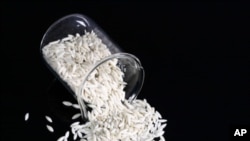Iron deficiency affects an estimated 3.5 billion people worldwide. In adults, it causes fatigue and lost productivity. It can increase the risk of infection and death in young children, and can also limit their motor skills and ability to learn later in life.
Iron deficiency and its more serious consequence, anemia, are especially common among people who don't eat meat or can't afford it, and who therefore subsist on grains. Wheat and maize are often fortified with iron. But rice has proved hard to fortify without adversely affecting its appearance or flavor.
Re-assembled rice
Diego Moretti at Wageningen University in the Netherlands and his colleagues tried using "fake" rice made out of iron-fortified rice-flour dough and shaped by machine into grains that look like the local variety.
"At first sight it sounds silly to first [grind] rice and then reassemble it with a machine," he says.
It may sound silly, but it worked. In a 2006 study in the American Journal of Clinical Nutrition, Moretti and colleagues mixed grains of fortified pseudo-rice in with real rice and served it to iron-deficient school children in India. Anemia fell by half among these children, while those who just ate regular rice did not improve. And the children could not tell the difference between fortified and unfortified rice.
Minimal cost
Mark Beinner at Brazil's Federal University of Minas Gerais just published a study in the January issue of the Journal of Nutrition in which he and his Brazilian colleagues used a version of this imitation rice to help improve the iron intake in very young children. He says when produced commercially at an industrial scale, the added cost is minimal.
"We're looking at a 3 to 5 percent increase in the cost of a 5-kilo bag of rice," he says. "That's not a lot. The cost of not doing anything is much more substantial in years of life lost not treating young populations that are anemic."
Brown University's Jennifer Friedman works in maternal and child health in the developing world. She says starting commercial production of the fortified rice is an essential first step. "But maintaining that over time is what's very hard. Really keeping that going, making sure those companies stay in business. Marketing that product in a way that people who often don't want to change their lifestyle and what they're doing is the other part that becomes costly."
The nonprofit organization PATH is giving it a try, working to commercialize a version called Ultra Rice in Brazil, Colombia, and India.
News
New Iron-Fortified Rice Reduces Anemia
update

Researchers are testing a new way to prevent the world's most common nutritional problem.



